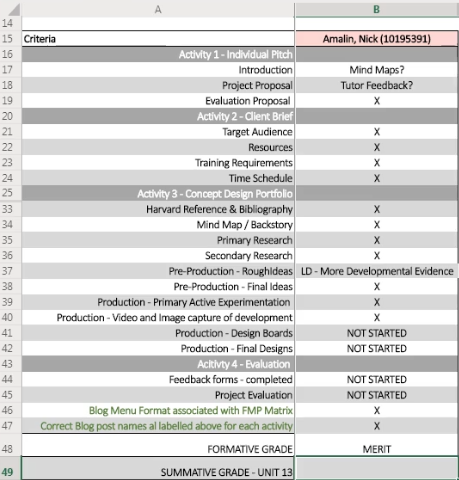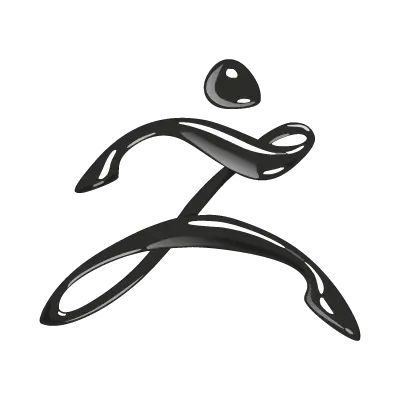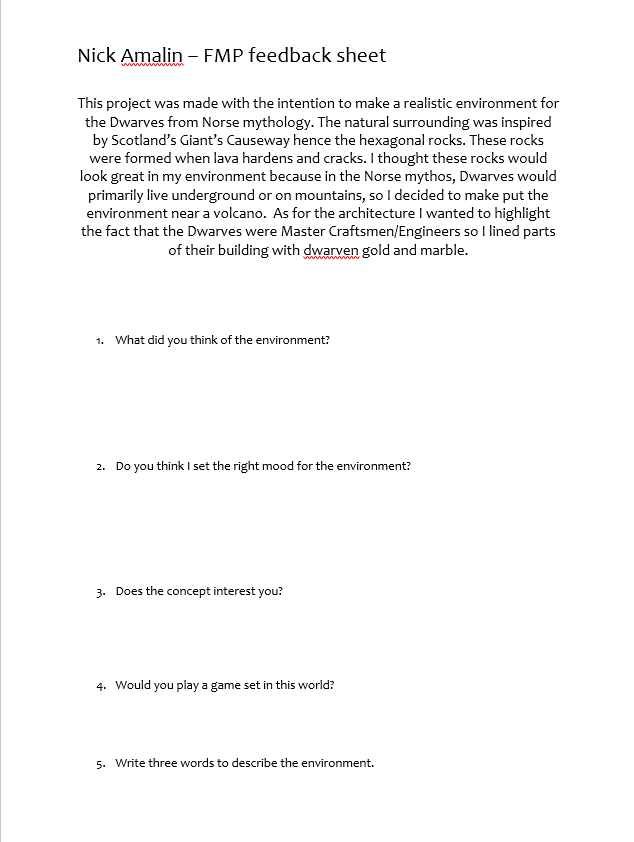Introduction
I have done all I can for the planning, pre-production, and production for this project. In this blog, I will wrap up everything. I will be saying how I felt throughout the entire project, how it went, the skills used and how I’ve improved over my time in Games Design as a whole, things I could improve on.
Tutor feedback

Before I finished production Gareth gave me feedback on my project to tell me what I need to complete and what I could do to improve. We did try to record this but unfortunately, the audio didn’t capture so I’ll just be using this screenshot to explain what Gareth told me.
As you can see by the tutor feedback sheet I have completed (X means completed) almost everything aside from the evaluation and a couple small tasks. This showed how organized and on task, I was for this project. All of the other tasks not completed could have been easily done within an hour so I wasn’t worried at all about completing them.
This feedback was also provided two weeks before the deadline and so far I had only produced assets. Gareth said that I may have to change my plans on making an environment and just provide the assets. At first, I thought I had time but as you may know now, I ended up just making the asset pack. This feedback did help me come up with a backup plan for the project and it was reassuring. This gave me confidence and I would say it was helpful in that regard.
Since I was nearly done with everything not much was really said, the feedback only reminded me of the tasks I forgot about.
How it went overall
Overall this whole project has probably been one of the most fun experiences I have had in Games Design. I had creative freedom over everything much like year one FMP but the difference is this time I made a 3D environment project which is what I specialize in. I found modeling and texturing fun since I was introduced to so many different software via workshops I was so eager to see what I could do.
Although overall I found this project fun, there were moments when I thought that I can’t see myself ever needing to do this in the future and that is the concept art and the block out. I have never really liked doing concept art but felt like I needed to do this because I wanted to carefully plan out my environment. If I ever work in the industry I know that someone else will have been hired for that job anyway so it really wasn’t on my list of priority.
I’m also really disappointed that I couldn’t make the environment before the deadline mainly due to the fact that I was on point with my organization, planning, and timing up until the last two weeks. I wasted a lot of time modeling assets I’d end up scrapping. Fortunately, Gareth suggested I make it into an asset pack instead. This put less stress on me during the final week.
These are my aims:
- To create at least one realistic level out of the 5 mentioned levels.
- Create an environment that shows off my skill as an environment artist.
- Create a realistic environment using high-quality textures made in substance painter.
And the three objectives for each aim:
- Create environments that fit the lore of each race.
- Create a simple block out of each environment to help scale each asset correctly.
- Create a timesheet that prioritizes the development of each environment.
- Utilize any unused space within the explorable zones.
- Use lighting to highlight points of interests.
- Produce a high-quality render of each level and assets.
- Get more familiar with Zbrush
- Use sculpting software such as Zbrush or Mudbox to produce high poly maps.
- Take high-quality pictures for alphas and foliage.
I didn’t complete any of my aims however, I did complete some of the objectives that go towards completing the aims. Completed all of the objectives for the third aim, created a block out and timesheet and I have also produced a high-quality render of assets. Since I never made an environment with the assets, all of the objectives that have to do with Unreal were not complete. Had I been given another week or had I not wasted my time doing of the assets, I would have definitely completed everything because I know I have skills for it it’s just poor planning in some areas made things last longer than it should have.
How I improved for last year
My first ever project was in the first year was an asset pack project.
When you compare year one asset pack to now, you can see that the quality of my models have improved and the most noteworthy improvement is the textures. This was because in year one we were restricted to texturing using photoshop which made it difficult making seamless textures. I also have a better understanding of normal maps, specular maps, roughness, and metalness because of substance painter. My standards have also improved from last year now that I have a better understanding of the workflow.
Another skill I’ve improved from last year is my time management skill. In this project, I was definitely more organized with my time with this project and my timesheet had little to do with this. I knew exactly what I needed to make and how I was going to make it thanks to all of the workshops provided to us after Game Jam and also because I’ve been planning this project since the start of the second year. It also helps that I now recognize what I specialize in, in the industry and I no longer have to experiment with what I have potential in just what I am best at.
A significant skill I’ve also improved at is my UV mapping. Prior to this project, I have only UV mapped using the automatic map tool or planar map on simple 3D models. I have never really understood how to deal with texture deformities or how to deal with seams until after the wild west competition but even then I felt as though I wasn’t that good since the bow I made for the project was a simple enough model to planar map. But now, with the guidance of my tutor and my peers, I was able to learn new techniques for mapping UVs. An example of this is automatic mapping, checking for any texture deformation and planar mapping or moving and sewing to fix the errors that the program couldn’t fix.
I didn’t just improve the skills I had from year one but I also learned new skills with this project. The most noteworthy skill I’ve learned with this project was Zbrush. I am not saying I have learned a lot about this sculpting software but I am glad to have an extra tool to make high-polygon assets. I will make sure to keep improving this skill because it is industry standards and having this skill in my CV could be very useful for me in the future.

Speaking of CV, I will be updating my CV based on my performance in this project. All of the skills improved and learned through this project are transferable skills I can take for university or work not just in the game industry but for film, engineering, architecture, interior design and with VR I can even branch out with work not traditionally associated with digital art like policing, teaching, medicine even more.
How to improve this project
I would say that the main thing I could do to improve this project is learning how to use Substance Designer.

This software is a texturing software much like Substance Painter. However, the difference is that Substance Designer works with nodes much like Unreal’s blueprint editor.

With this, I would have been able to make procedural textures which is difficult to make in substance alone. What a procedural texture is a texture that when applied to any mesh, would still generate correctly. This would have made tiling easy but also textures would have been more customizable.
There are many tutorials on Substance Designer so learning how to use this software shouldn’t be hard, I’ll just need time to learn.
Feedback sheets
Later this month there will be an art show where I and along with my class present our projects to the public as well as students from other courses. I could use this day as a chance for me to get feedback from other people. This could be useful for me since our visitors will most likely have no knowledge of game art/design but that could mean they have ideas that may not have been explored yet.
To get their feedback I made a feedback sheet. Here I will ask them to answer the questions asked and give their honest opinions.

Conclusion
Before game design, I had started off with almost zero knowledge of the industry but had a passion for design. I had originally wanted to become an architect so I had a small amount of experience with CAD but if you told me back then that I’d be producing work of this quality I probably would not have believed you. This project shows how far I’ve come. I am now more confident in my skill and am ready to prove myself in university but also in the working world. Everything that I learned in Games Design is so versatile that I don’t have to restrict myself to the game industry. I can see myself improving to such a level where I am capable of making movie ready model.



